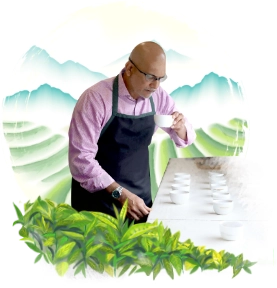The Mesmerizing World of Teapots
The origin and evolution of teapots is a mesmerizing journey through centuries of cultural exchange, innovation, and craftsmanship. What began as a simple vessel made of clay to brew the humble tea leaf in China around 7th-10 century CE during the Tang Dynasty, evolved into a work of art and aesthetic from the 14th century during the Ming Dynasty. Since the 14th century, as tea travelled out of China and Japan to every corner of the world, teapots have become a reflection of the times and culture, symbolising the finest craftsmanship in Japan, England, Russia, Turkey, India, Sri Lanka and many more.
Here are some famous teapots from all over the world:
CHINA
Chinese tea pots hold a special place in the world of tea and craftsmanship. These teapots are not only functional vessels for brewing tea but are often considered works of art due to their rich history, unique designs, and the skill required to create them, symbolising the richness of Chinese culture and hospitality.
Yixing Teapots
Pronounced ee shing, Yixing is a region in Jiangsu province, is renowned for producing some of the most famous Chinese teapots. Yixing teapots are traditionally made from purple clay, which is highly porous and known for its ability to absorb and enhance the flavor of tea. These teapots are often unglazed, allowing the clay’s natural properties to shine.
Yixing teapot production dates back to the Ming Dynasty (1368-1644 CE) and has continued for centuries. Over the years, many varieties of Yixing teapots have evolved, each created for a particular type of tea like oolong tea, black tea, green tea, and more. The shape, size, and clay used can all influence the brewing process.
What makes Yixing teapots unique is the ‘seasoning’ – when used for long periods of time, Yixing teapots tend to ‘season’ – absorbing the aroma and flavour of the teas that are brewed in them. Seasoned Yixing teapots are extremely rare and highly valued by connoisseurs and collectors. This seasoning process is highly valued, as it is believed to enhance the tea’s taste over the years.
Zisha Clay Teapots
Amongst the earliest teapots made in China were made around the 12th-13th century using Zisha clay. Zisha clay is also purple in color, much like that used in Yixing teapots. Zisha teapots are renowned for their ability to enhance the flavor of the tea.
Blue And White Porcelain Teapots
These teapots are decorated with intricate blue designs on a white porcelain background. They are highly versatile and can be used for different types of tea. Blue and white porcelain teapots are one of the most popular and distinctive of Chinese teapots.
JAPAN
Tea travelled from China to Japan around the 7th century with the Buddhist monks. Since then, Japan has had a rich tradition of tea culture, and this is reflected in the variety of teapots designed specifically for brewing and serving Japanese teas.
Kyusu Takomane
The Kyusu is perhaps the most iconic Japanese teapot. It is characterized by its side handle and typically made from ceramic or clay. Kyusus come in various shapes and sizes, each tailored to specific types of Japanese tea. For example, a Kyusu for Sencha (green tea) may have a wide, shallow shape, while one for Gyokuro (a premium green tea) may be smaller and more refined. The side handle allows for precise pouring.
The two most popular types of clay used for Kyusu teapots are Banko from Yokkaichi, Mie prefecture, and Tokoname from Tokoname, Aichi prefecture. Of the two, Kyusu Takomane is the more popular, easily identifiable with its distinctive reddish color.
Tetsubin
Tetsubin refers to a cast iron teapot in Japanese. It has its origin linked to the famous Japanese Tea Ceremony, but is also originally thought to have originated in China. Tetsubins are generally used during the Japanese Tea Ceremony to boil water – tea is not brewed in these, and hence, cannot be strictly called teapots, but tea kettles. The actual Tetsubin used to brew tea is called Tetsubinkyusu.
Hōhin
Similar to the Kyusu, the hōhin is a Japanese teapot but without a handle. Instead, it has a small knob-like protrusion for pouring. This design allows for better control over the flow of hot water when brewing delicate teas like Gyokuro.
Kibishisashi Teapots
These teapots are made from fine porcelain and are known for their elegant and delicate appearance. They are often used for brewing premium green teas.
ENGLAND
Tea came to England in the 17th century. Initially, it was a luxury that was only reserved and available to the aristocracy, who loved to show off their affluence by serving tea in imported bone china teapots and tea cups.
It was only in the 18th century that teapots started to be made in English potteries, thanks to the efforts of people like Josiah Spode and Josiah Wedgwood. Soon, the English teapots started to have their own distinctive style.
Chintz Teapots
One of the most timeless of all teapot designs, you cannot miss the colourful and densely floral patterns – bright, cheerful and very, very flowery.
Brown Betty Teapots
Brown Betty teapots are about as English one can get. It is a round teapot with a signature manganese brown glaze, also known famously as the Rockingham glaze. The original Brown Betty teapots were made from red clay found abundantly around Stoke-on-Trent. During the Victorian era, teas brewed in Brown Betty teapots were considered to be of the most excellent quality as the round shape was thought to allow sufficient room for the tea leaves to brew.
Staffordshire Teapots
In the 17th century, the county of Staffordshire became the hub of the English ceramic pottery industry. With innovators like Josiah Wedgwood and Josiah Spode, who used the rich local clay with newer pottery making techniques, an entirely novel kind of pottery evolved, popularly known as Staffordshire. Such was the rapid rise in demand for Staffordshire ceramics that by the mid 18th century, as many as 300 potworks were thriving in the six towns around Stoke-on-Trent (collectively referred to as The Potteries). Such was the popularity and demand of Staffordshire ceramics that every product had a Staffordshire mark as well as a potter’s unique identification mark.
Some of the famous English pottery works include Wedgwood, Spode, Royal Doulton, Jasperware, Royal Stafford, Aynsley and Burleigh.
Queen Anne Teapot
The iconic, exquisite and elegant Queen Anne teapot is part of the larger Queen Anne silverware. Queen Anne ruled from 1702 to 1714. What makes Queen Anne silverware so distinguishable is the unpretentious and clean design, compared to the overtly ornamental baroque style before Queen Anne. Another easy identifying feature of a Queen Anne teapot is its distinctive black handle, usually made out by carving and painting high-quality wood like ebony.
RUSSIA
Gzhel Teapots
Gzhel porcelain is a distinct style of Russian ceramics with signature blue and white designs. Gzhel is actually a region located to the southeast of Moscow, and has a long history of pottery production dating back to the 14th century.
Gzhel porcelain production received a significant boost in the 18th century when it gained the favor of the Russian imperial court. Empress Elizabeth and later Catherine the Great supported and encouraged porcelain production in Gzhel. The iconic cobalt blue designs are painted on a white porcelain background, often featuring floral patterns, landscapes, and traditional Russian motifs. The blue and white palette is inspired by Chinese and Dutch porcelain but incorporates Russian themes.
TURKEY
Çaydanlik
Turkish tea pots, known as “çaydanlik” in Turkish, are a distinctive type of teapot designed specifically for brewing and serving Turkish tea. They have a unique two-chamber design that allows for the brewing of strong tea and its subsequent dilution with hot water to achieve the desired strength.
Çaydanlik is typically made from metal – stainless steel, copper, or brass. Copper and brass pots are valued for their traditional appearance and heat conductivity. The lower chamber, which is larger and holds the concentrated tea, is called the “demlik.” The upper chamber, known as the “kettle” or “çaydanlık üstü,” holds the hot water. This design allows for controlled dilution of the tea to achieve the desired strength.
To serve tea, hot water from the upper chamber is mixed with concentrated tea from the lower chamber in the desired ratio, typically around one-third tea to two-thirds hot water.
Teapots have always been one of the most sought after teaware. Each teapot has evolved over time in line with the tea-drinking culture. From shape and size to material and construction, each kind of teapot has evolved to bring out the delicate flavor and aroma of different teas.

Tea is a religion in the art of life.

